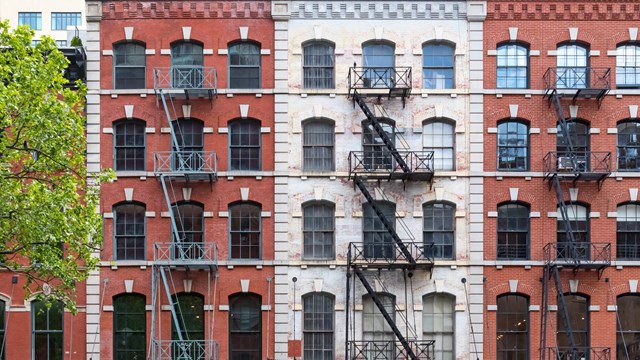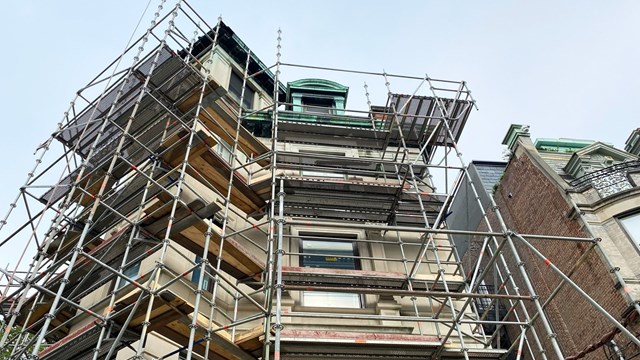New York City has over 80 historic districts featuring unique styles of design, exceptional attention to cultural details, and hand-painted or hand-carved architectural embellishments. Of course, a lot of these historic gems are homes to modern people with modern lifestyles and repairing, renovating or changing these buildings in any manner may require special permission.
"The people of New York care about the beautiful buildings as much as we do and we want the buildings to retain this beauty," says Sherida E. Paulsen, chair of the New York City Landmarks Preservation Commission (LPC). The LPC is the city agency responsible for designating and regulating landmarks. The Commission has the authority to protect these landmarks–including residential buildings–from any alterations they believe might be harmful to their aesthetic or historic value. A landmark is a building, property, or object that has been designated as such by the LPC for its special character, historical or aesthetic interest, or value as part of the development, heritage, or cultural characteristics of the city, state, or nation. (Landmarks are not always buildings. A landmark can be a bridge, a park, a water tower, a pier, a cemetery, a building’s lobby, a sidewalk clock, a fence, or even a tree.) A property or object is eligible for landmark status when part of it is at least 30 years old.
The Commish
"We understand it’s a hoop to jump through for an owner to apply for a permit, but we try to make the process as pleasant as possible," says Paulsen.
Tim Fine, managing director at Charles H. Greenthal Management Co., welcomes the process of LPC approval on restoration projects. "Management and Landmarks want the same thing; a beautiful building that is well-preserved and retains the style in which it was constructed," he says.
According to the Commission, every designated structure, whether it is an individual landmark or a building in a historic district, is protected under the Landmarks Law and subject to the same review procedures. The Landmarks Law was enacted in the mid-1960s to protect the city’s architectural, historical and cultural heritage. Any exterior changes to landmarked buildings–no matter how minor–require the LPC’s permission.
The application process begins with a phone call to the LPC where, according to Paulsen, not only can you find out if your building is already landmarked, but also if a permit is even needed. For example, repainting previously painted masonry or wood the same color or removing graffiti with approved graffiti removal can be done without a permit. However, repairing, repointing, or resurfacing masonry, replacing brick, cleaning exterior wall surfaces, stripping paint, painting façade surfaces a different color, and other visual changes to the exterior of the building all require a permit. Guidelines also state that work on the interior of a building that will affect a building’s exterior, (such as installing an air conditioning wall unit), must have a permit as well.
According to Linda Peters, president of The Sea Crest Group, an exterior restoration and preservation company, "The biggest problem with landmark restoration is [the] dollars–and sense–needed to keep its historic preservation. You have to adhere to parameters, and it can also be a long process." Peters’ advice to boards considering any sort of renovation or remodeling is, "If you’re in doubt, first ask the Commission if your building is landmarked." To date, the Commission has designated 1,078 individual landmarks, 103 interior landmarks, nine scenic landmarks and 80 historic districts in New York City, and new applications arrive regularly.
According to Peters, "If everyone is on the same wavelength, the project can go smoothly, but some items may be difficult to find, and it may take extra time because of the approvals that need to be done. The process then takes longer than normal because you need to adhere to what the Commission wants."
Take a Number
If a permit is needed, it is time to position your team for maximum efficacy. "An owner can do the application him or herself, but an architect and contractor can help move things along," says Jeff MacGregor, vice president of Preserv Inc., an exterior masonry restoration firm in Brooklyn. "Architects and contractors experienced in historic restoration have gone through the process and can reduce the chance that the Commission is going to come back with a million questions."
Once the paperwork is in hand, the goal of the LPC is to have applications processed within five to ten business days. "We receive 400 to 600 applications each month and that hasn’t dropped, but we still try to get applications processed in under two weeks," says Paulsen.
The Commission issues different permits, such as a Certificate of No Effect, which means that your proposed work does not affect the architectural features of a building. According to MacGregor, "This is work that does not affect the outside of the building–including plumbing work and interior work–as long as it’s not a landmarked interior."
By contrast, a Certificate of Minor Work affects the architectural features of the building, but the intent of the work is to restore and repair those features. A Certificate of Appropriateness means the work being done significantly affects the building’s exterior features. This permit requires a public hearing.
"If you want to put a penthouse on top or remove a significant part of the building, such as its cornice, you need to appear at a public hearing," says MacGregor. "The Commission is reasonable because we think it’s important when you are working on an historic building to be sensitive to its architectural style."
Depending on the permit required and the size of the job, a permit application should include blueprints on how the building is going to be altered, photographs of what part of the building is going to be affected, and all the specifications necessary to complete the job. "We take a hard look at the proposal," says Paulsen, "and decide whether it’s a staff-level approval or if you need to present in front of the public. This public presentation permit can take six to eightweeks."
Through the Legal Thicket
"The Landmarks [Commission] is watching out for the building," says Steven Reif, vice president of Landmark Restoration and Construction Corporation in Long Island City. "If you have the job all spec-ed out, it saves problems with the Commission. Then you can take those specs and put out a bid to different experienced contractors."
Reif explains that he is usually brought on the job after all the paperwork has been completed and he can examine specifications. "By then the color submittals and all the problems are worked out between the owner and the Commission," he says.
Though it sounds fairly painless, problems with landmark permits can arise. Manhattan-based attorney C. Jaye Berger suggests minimizing your trouble by using reputable contractors and architects experienced in historic restoration. A contract to outline all job responsibilities is imperative, and she suggests all clients stay on top of application dates. "You might be waiting for an approval and it never comes," says Berger. "An attorney can step in and expedite the process."
A proper application packet does not guarantee an approval, however. "We might judge that your project is too damaging to the overall architecture of the building," says Paulsen. For example, an air conditioning wall unit may cut into the ornamentation of the building’s façade. That may be unacceptable–and according to Paulsen, no means no. "If we deny it," Paulsen says, "there’s no appeal."
Paulsen does point out, however, that changes could be recommended. "If we can’t find your idea exactly appropriate, [we may] offer suggestions, like moving the unit, or changing a paint color, [and] we will encourage you to come back as quickly as possible to give you the approval once you have met the changes."
Hammer and Tongs
Once permits are granted, the job can begin. The LPC does not have an official inspection team, but believes the public eye helps them to do their job. "What we found on work in the historic district is that when members of the public see scaffolding going up, they will watch the work and let us know if something doesn’t look right," says Paulsen.
Accessible and user-friendly as they try to be, however, the Commission does not take kindly to those who choose to work on landmarked buildings without proper approval. "Our fines are not geared toward generating revenue, but for encouraging compliance," says Paulsen. Violators are issued a warning letter, and if it is ignored, fines of $5,000 per day–or more–are issued. Paulsen warns that violations are kept on file and can cause complications for owners if the property comes up for sale.
In the long run, an ounce of bureaucracy is worth a pound of cure. "It’s much easier to simply go with the flow and get the job done right," says Christopher Thomas, senior vice president and sales director for William B. May, a real estate brokerage firm in Brooklyn Heights (an area thick with landmarked properties). According to Thomas, "If you’re going to sell a property, a title search can turn up violations of the Landmarks Preservation Commission and lenders won’t lend money until the violations are cured."
Thomas adds that properly caring for a landmarked building can be a fiscal benefit to owners and residents. "There is an ancillary benefit to landmarking," he says. "Property values have gone up because all of your neighbors are subject to the same rules. The aesthetics of the neighborhood are going to increase equity and property value."
There’s a reason New York City is often referred to as "Gotham." We as a community appreciate the sense of history that lingers over our town, and it’s no coincidence that a group like the Landmarks Preservation Commission exists to preserve and protect the stately structures that give New York a look like no other city in America.
Lisa Iannucci is a freelance writer living in Poughkeepsie, New York.







Leave a Comment